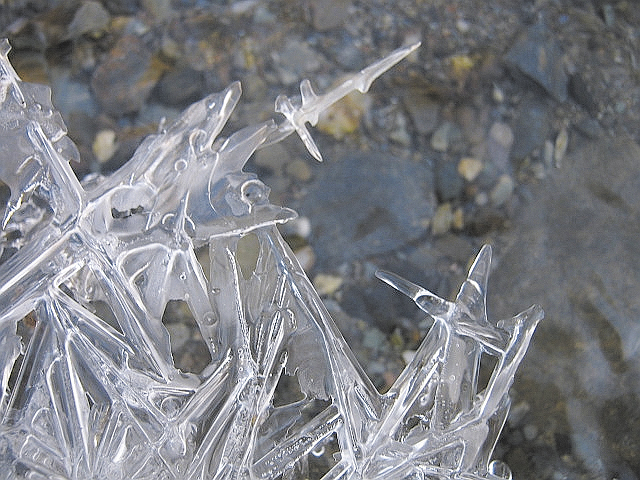This is the time of year when it’s easy to believe that 25,000 years ago, our part of the world was covered by 8,000 feet of ice. Ice a mile and a half deep. So much ice that the ocean was frozen over 180 miles offshore. So much ice that its weight depressed the earth surface hundreds of feet beneath where it is today.
Here in mid-January, I do not find any of this hard to believe. In fact if I had to guess, I’d say that the ice now covering the lower part of my driveway is a remnant of that Laurentide Ice Sheet which never completely melted after things started warming up around 15,000 years ago.
The ancient cold cycle starts around the autumn equinox in September, as the Earth’s tilt and orbit move us out of the sun’s direct rays and arctic air filters south. The cold usually gets its real grip during December. Floating around in the frigid air are grains of dust and pollen or even bacteria, around which water vapor condenses and freezes into crystals.
How and why water freezes, exactly, is not well understood. Each snow crystal forms in one of seven latticed patterns: plates, stellars, needles, columns, capped columns, spatial dendrites, and irregulars. Apparently, as the International Commission on Snow and Ice concluded in 1951, no two snow crystals are exactly alike. A cubic foot of snow can contain 10 million unique flakes. At the time of the glacier there were approximately 7,727 million million cubic feet of ice crushing Maine. And that’s not counting the mountains plowed up at the top of my driveway this month.
Thirteen different kinds of ice can exist chemically: Ice I through Ice XIII. But we see only forms of Ice I because earthly temperature and pressure conditions don’t allow the other structures to grow naturally. Here in the Great White Northeast we give names to the many manifestations of Ice I that appear here from September to … whenever.
Take simple frost, for example. One kind is rime, which forms when water droplets freeze on contact with an object such as a blade of grass. Its cousin, hoarfrost, grows outward directly from vapor to solid.
A thin coating of ice is called verglas; black ice on the road is apparently a kind of verglas. Plate ice forms on still water (e.g., the condition of my lower driveway three to four years per winter month). An ice lens is a buildup of lens-shaped ice in soil; it causes frost heaves. Pingo ice is a huge ice lens underneath a pond, pushing up a hill of ice. Pack ice is long-lasting ice cover over ocean water; an ice floe is a chunk of pack ice moving with a current. An iceberg is a renegade piece of a glacier.
Sometimes, especially in March when winter can’t make up its mind whether to further overstay its welcome or depart, you see patches of ground with little frozen points sticking up; this is called pipkrake, or needle ice. Decayed ice with little candlelike protrusions is called candled ice. Fine, small, needle-like shapes and thin, flat, circular plates of ice suspended in water are called frazil.
And then there are the forms of ice we categorize as “snow.” There’s powder, dusting and hardpack. There’s snow mixed with rain; sleet (defined by the National Weather Service as ice pellets of frozen or mostly frozen or refrozen or partially melted raindrops); freezing rain (falling as liquid, then freezing on impact); and hail (ice falling out of the sky!).
There are kinds of snow you sometimes see but don’t name, probably because they’re not dangerous. Snow that’s partly melted and refrozen and acts like ball-bearings is called corn snow. Little balls of snow about the size of BBs that you sometimes see bouncing around the ground are called graupel. Graupel is different from snow pellets, which are smaller, but larger than snow grains.
Except in the delusive psychic state that every winter seems to glacialize all of time into one eternal span euphemistically called “January,” we do not have to worry about firn, which is glacial snow that survives at least one season (though in my driveway it seems to be having a shot at it every April) or neve, enormously compacted ice underneath the glacier. In Maine we also do not have permafrost, which is soil that stays frozen for more than two years in a row.
And these are just manifestations of Ice I. What state of mind would we be in if we had to grapple with the graupel of alien ice forms from Ice II, Ice III, or Ice IX?
According to “The Changing Nature of the Maine Woods,” a fascinating book by UMaine at Farmington professor Andrew Barton, over the past 100,000 years it has been deep cold here for tens of thousands of years longer than it’s been warm. To my mind of winter, this is not hard to believe. It sounds like the macrotime version of one Maine seasonal round: cold, colder, cold, and the Fourth of July. And July itself, as far as I can tell, is just a legend at this point.
Dana Wilde lives in Troy. His writings on Maine’s natural world are collected in “The Other End of the Driveway,” available from Booklocker.com. Backyard Naturalist appears the second and fourth Thursdays of the month. You can contact him at naturalist@dwildepress.net.
Send questions/comments to the editors.



